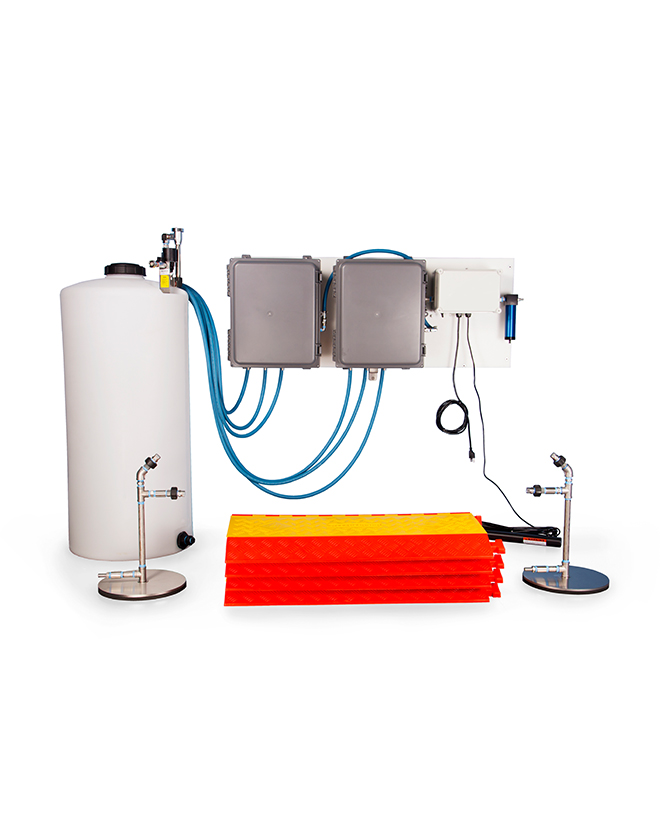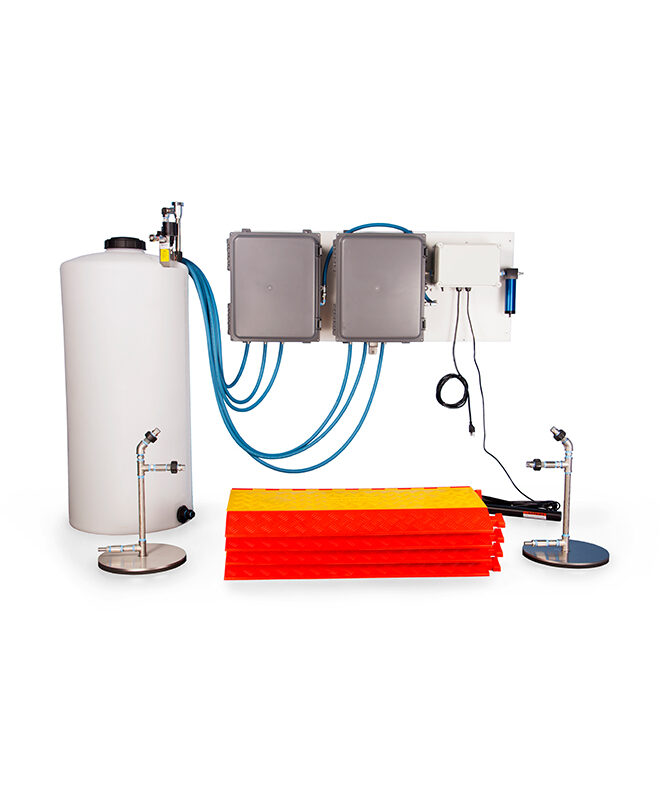- QUICK LINKS:
- Get A Quote

features
- applies foaming product to vehicle underbody
- works with trucks and passenger vehicles
- vehicle ground clearance: 7-49 in. (17.8-124.5 cm)
- vehicle weight: up to 40,000 lbs (18.14 metric tons) per axle
- sensor-operated system starts when vehicles approach – no need for an attendant
- foam provides long contact times for maximum chemical effectiveness, and a visual way to verify coverage
- easy to install
- draws from concentrated product (includes proportioning tank)
- dilutes at ratios of 4:1 to 530:1 (water:chemical)
- powered by compressed air and electricity
- low-pressure system
- includes water separator to protect pumps
Datasheet
Drive Over Foam Unit
User Manual
Drive Over Foam Unit
Questions?
- power type
compressed air and electricity
- chemical pickup type
draws from concentrated product (includes proportioning tank)
- dilution ratio range (water:chemical)
4:1 to 530:1
NOTE: approximate dilutions at 40 psi (2.6 bar) water pressure for water-thin products at 1.0 cP.- number of products unit can draw from
one product
- suction line length/diameter
from proportioning tank to chemical source: one suction line, 9 ft. (2.7 m) of clear hose with 1/2 in. (12.7 mm) inside diameter
from pump box to proportioning tank: six suction lines, each 10 ft. (3.1 m) of blue hose with 3/8 in. (9.5 mm) inside diameter- capacity
proportioning tank: 55 gallons (208.2 liters)
- flow rate
13 gal/min (49.2 l/min)
NOTE: flow rate based on chemical with viscosity of water and factory air settings.- pump seals
Santoprene, Viton, or Kalrez
- number of nozzles
includes five ramp nozzle assemblies and two side nozzle assemblies
- distance from nozzles to control panel
minimum: 30 ft. (9.1 m)
maximum: approximately 50 ft. (15.2 m)- tubing/fitting sizes
designed for use with 1/2 in. (12.7 mm) inside diameter hose between control panel and nozzles
- vehicle ground clearance
7-49 in. (17.8-124.5 cm)
- coverage area
with 7 in. (17.8 cm) vehicle ground clearance, coverage area will be up to 65 in. (165.1 cm) wide
with 49 in. (124.5 cm) vehicle ground clearance, coverage area will be up to 102 in. (259.1 cm) wide- vehicle weight
up to 40,000 pounds (18.14 metric tons) per axle
- ramp width
12 ft. (3.6 m)
- traffic flow direction
suitable for traffic moving in one or both directions
- sensor type
detects moving iron-based metal
- compressed air requirements
50 psi (3.4 bar) with 20 cfm (566.3 l/min)
- water requirements
25-100 psi (1.7-6.9 bar)
backflow prevention is required – consult local plumbing ordinances for more information- liquid temperature range
40-100˚F (4.4-37˚C)
- electrical requirements
120 VAC at 60 Hz, 2 amps (GFCI protected outlet)
- operating voltage
120 VAC
- chemical compatibility
Chemical products used with this equipment must be formulated for this type of application and compatible with unit materials and pump seals. For more information on chemical compatibility, consult the manufacturer or SDS for your product or contact our customer service department.
- 55 gallon (208.2 liter) proportioning tank
- control panel assembly
- ramp (in 4 sections)
- 5 ramp nozzle assemblies
- 2 side nozzle assemblies
- sensor
- 230 ft. (70.1 m) of 1/2 in. (12.7 mm) inside diameter blue hose
- control panel mounting hardware
- user manual
Support Videos
FAQs
Which pump seal material should I choose?
Pump Seal Material Compatibility
Choose a pump seal material that is compatible with the chemicals you will use. Chemical incompatibility can cause accelerated wear and equipment failure that is not covered by warranty, so it’s important to do your research.
- Consult the safety data sheet (SDS) for your chemical to learn about the ingredients.
- Use a chemical compatibility database (like this one: https://www.coleparmer.com/Chemical-Resistance) to look up the ingredients and find material compatibility info.
- Note that the concentration of chemicals makes a big difference in compatibility. Think about whether the chemical you use will be in a pre-diluted or concentrated form when it is used in the equipment.
- If you need help, ask your chemical manufacturer. Or, send your SDS to techsupport@foamit.com and we can help.

How to Buy?
We have distributors all over the world. Tell us a little bit about you and your equipment needs, and we’ll help you find or become a distributor.